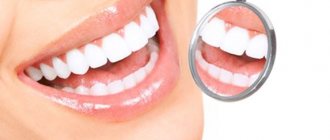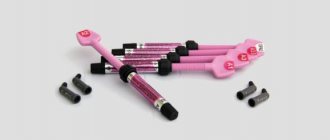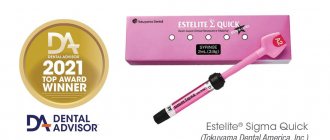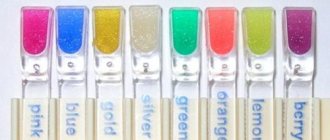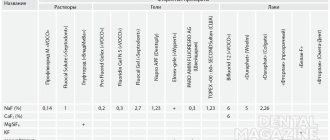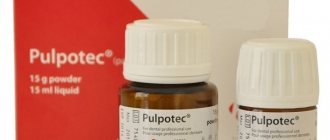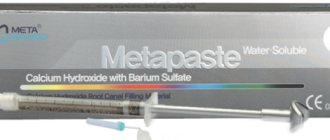Apexdent is a filling adhesive paste that fills tooth canals. It is an X-ray contrast material that is used to seal inflamed and infected difficult-to-pass areas of the canal.
Apexdent is produced in the form of a homogeneous paste with calcium hydroxide, which can be with or without iodoform.
Modern material has been approved by many leading experts.
Release form and composition
Apexdent without iodoform contains:
- calcium hydroxide for dental tissue regeneration;
- calcium phosphate, which actively stimulates the formation of osteoblasts, is intended for the mineralization of dental bone tissue;
- X-ray contrast filler;
- a paste agent that makes it easy to fill small cavities.
Apexdent with iodoform contains 40% of this substance, which ensures a long-term antibacterial effect and prevents re-infection of the tooth.
The filling material is produced in the form of a homogeneous paste, completely ready for use. Packaged in syringes of 2 g. The kit may include special curved needles (5 pcs.).
This material belongs to the long-hardening type. Certified and complies with GOST R 51059-97. Produced by VladMiVa (Russia).
Possibility of use
If a version of the paste without iodoform is used to treat periodontitis, then the following plan should be followed:
- Substances are added to a canal that is ready and free of dirt and infection in advance and stored there for a week.
- Then they are separated with cotton wool and a filling is installed for a certain time, thereby preventing the tooth from becoming infected.
- After several days, the paste is cleaned and washed with a disinfectant.
- Dry and add the following paste, now for a month
Now this procedure is repeated every three months, for from six months to 1.5 years. At the end of the first three months, an x-ray of the tooth is taken and a decision is made to continue the treatment further or to finish it.
Pulpitis, if the apex of the root tooth is not closed, is treated as follows:
- They perform a pulpotomy and do not forget about pain relief
- Cleaning the channels
- Cover the treated pulp with paste
- Seal and place a temporary seal
- Then they wait a month and add a new batch of pasta
- Look at the x-ray, repeat step 5 until the root is closed
- At the final stage, a permanent filling is installed
How does apexification of teeth take place?
- First the channel is processed
- Then washed with a special liquid
- Dry and add filling paste
- Place a filling for a specific time
- And they change the entered content every month
Then an x-ray of the tooth is also taken, and if it returns to normal, a permanent filling is placed.
How to work with a syringe and the drug
Intolerance to Apexdent is possible, especially in people who are allergic to iodine.
After use, you need to remove the needle and tip from the syringe, then wash it and close it properly. The main thing is not to allow air to get inside, otherwise the paste will harden before use.
Each product comes with instructions for use, which should be read carefully.
Basic properties
Due to its high pH level (˃12), calcium hydroxide has a long-lasting antiseptic effect. The use of Apexdent promotes:
- long-term bactericidal effect on inflamed dental tissues and the periapical area;
- creating a strong dentinal barrier and creating conditions for the formation of a tooth root (within 3 – 6 months the apical root hole is formed);
- restoration of hard dental tissues.
After using dental paste with iodoform for chronic periodontitis, within the next 6 to 14 months it becomes possible to finally fill the canals.
If the filling paste was carried beyond the apex during operation, it gradually dissolves. The patient will not experience pain or discomfort.
Possibilities of the drug
Calcium hydroxide can create a long-lasting antiseptic effect. Due to the presence of special components in it. Apexdent is capable of the following:
- Prevents the appearance of bacteria on inflamed dental tissues and in the periacular area
- It creates a dentinal barrier and makes it possible for the formation of a tooth root to occur; this goes away within a few months.
- Restores tooth tissues that are responsible for its formation
When using Apexdent Vladmiva with iodoform, you can cure chronic periodontitis if you have it. Over the next six months to a year, it will be possible to completely close the canals in the teeth using permanent fillings.
If during endodontic treatment the paste goes beyond the apex, it will not cause damage to health and will not cause discomfort or pain.
Scope of application
Apexdent is suitable for the treatment of pulpless teeth (where the nerve has been removed). Paste without iodoform is prescribed for:
- apexification of the tooth (the process of formation of the apex of the dental root), when the process of root growth is not completed;
- closing the wide opening of the apex;
- treatment of pulpitis (inflammation of dental tissues, nerve);
- treatment of chronic periodontitis of molars in which the roots are formed;
- filling canals (difficult to pass) after pulp removal.
A paste containing iodoform is used for similar processes occurring in diseased dental tissues.
The specific difference is that it is more often prescribed for the treatment of infected canals. Indicated for chronic periodontitis.
Iodoform-containing paste is also widely used for filling dental canals. The product is used for:
- treatment of chronic inflammation of the tooth shell;
- bone resorption (destruction of bone tissue) and perforation of the tooth root;
- infection of dental canals;
- damage to the nerve and surrounding tissues;
- unformed tooth root apex.
The material is used in the periapical (near-apical) zones in combination with gutta-percha pins.
Clinical researches
“Results of clinical use of the Asepta series of products: already at the first control examination (after 1-2 days) of using the Asepta line of products, there is a decrease in complaints of discomfort, but bleeding persists when brushing teeth. On the 7th day, complaints of gum bleeding persisted in 4 patients. Upon examination, a decrease in hyperemia and swelling of the gums was noted, but bleeding persisted upon probing. After the final application of the gel with propolis, normalization of clinical manifestations was revealed, which is manifested by the absence of bleeding during brushing and probing.”
Sources:
- The effectiveness of the use of Asept “adhesive balm” and Asept “gel with propolis” in the treatment of chronic generalized periodontitis and gingivitis in the acute stage (Municipal Dental Clinic No. 4, Bryansk, Kaminskaya T. M. Head of the therapeutic department Kaminskaya Tatyana Mikhailovna MUZ City Dental Clinic No. 4, Bryansk
- Study of the clinical effectiveness of treatment and prophylactic agents of the Asepta line in the treatment of inflammatory periodontal diseases (A.I. Grudyanov, I.Yu. Aleksandrovskaya, V.Yu. Korzunina) A.I. GRUDYANOV, Doctor of Medical Sciences, Prof., Head of Department I.Yu. ALEXANDROVSKAYA, Ph.D. V.Yu. KORZUNINA, asp. Department of Periodontology, Central Research Institute of Dentistry and Maxillofacial Surgery, Rosmedtekhnologii, Moscow
- The role of anti-inflammatory rinse in the treatment of periodontal diseases (L.Yu. Orekhova, A.A. Leontyev, S.B. Ulitovsky) L.Yu. OREKHOVA, Doctor of Medical Sciences, Prof., Head of Department; A.A. LEONTIEV, dentist; S.B. ULITOVSKY, Doctor of Medical Sciences, Prof. Department of Therapeutic Dentistry of St. Petersburg State Medical University named after. acad. I. P. Pavlova
- Report on the determination/confirmation of the preventive properties of personal oral hygiene products “ASEPTA PLUS” Remineralization doctor-researcher A.A. Leontyev, head Department of Preventive Dentistry, Doctor of Medical Sciences, Professor S.B. Ulitovsky First St. Petersburg State Medical University named after. acad. I.P. Pavlova, Department of Preventive Dentistry
- Clinical studies of antisensitive toothpaste “Asepta Sensitive” (A.A. Leontyev, O.V. Kalinina, S.B. Ulitovsky) A.A. LEONTIEV, dentist O.V. KALININA, dentist S.B. ULITOVSKY, Doctor of Medical Sciences, Prof. Department of Therapeutic Dentistry, St. Petersburg State Medical University named after. acad. I.P. Pavlova
Mode of application
If the paste (without iodoform) is used in the treatment of periodontitis, the procedure is as follows:
- the product is placed into the prepared and cleaned canal using a canal filler and left for 7 – 10 days;
- isolate with a tampon, place a temporary filling, sealing the tooth;
- within the prescribed period, the paste is removed, the channels are cleaned and washed with a special composition (sodium hypochlorite);
- dried, a new portion of material is introduced (for 1 month).
This procedure is carried out every 3 months, for 6 to 15 months. Three months after the first treatment, an x-ray is taken to evaluate the effect. Then, depending on the results, a permanent filling is placed or therapy is continued.
Treatment of pulpitis with unfinished growth of the root apex of the tooth involves:
- performing pulpotomy with anesthesia;
- rinsing the canals;
- direct coating of treated pulp material;
- compacting the paste with a tampon, installing a temporary filling;
- replacing the drug after 3–4 weeks with a fresh portion;
- X-ray control, repeating the course until the final formation of the root;
- installation of a permanent filling.
When using Apexdent for apexification of a tooth, the following is performed:
- traditional dental canal treatment;
- washing with a special composition without pressure;
- drying and introducing filling paste;
- installation of a temporary filling followed by an x-ray;
- replacement with a new portion (after 3 – 4 weeks).
Approximately 3 months from the start of treatment, the condition of the tooth root is determined. Depending on the results, treatment is continued or the canal is finally closed with a permanent filling.
Modern Pharmaceuticals of Russia
Iodoform substance-powder, bottle 25 g
Composition of iodoform
Iodoform contains at least 98% of the main substance triiodomethane. It is a finely crystalline powder of lemon-yellow color, practically insoluble in water, easily soluble in ether, chloroform, slightly soluble in alcohol, gasoline, and organic oils.
Properties of iodoform
Iodoform is a broad-spectrum antiseptic. Under the influence of light and air, tissue secretions, it slowly decomposes with the release of iodine. Iodine has an antimicrobial, disintegrating, anti-inflammatory and absorbent effect, promotes granulation and wound cleansing.
Iodine albuminates are formed on the surface of wounds, resulting in an astringent and anesthetic effect, preventing irritation of the receptors. In terms of the degree of impact on the body when applied to the skin, the drug belongs to class 3 of moderately hazardous substances according to GOST 12.1.007-76. Does not have a local irritant or resorptive toxic effect.
Indications for use
Treatment of infected and postoperative wounds, ulcers, fistulas, dermatitis, tendovaginitis.
Dosage and method of administration
Iodoform is used externally in the form of a powder. The drug is applied in a thin layer to infected, postoperative wounds, ulcers or fistulas, covering healthy tissue at a distance of 2 - 3 cm. Repeated treatments are carried out according to surgical indications.
For the treatment of fistulas, wounds with pockets, as well as for the treatment of burns of bacterial etiology, iodoform is dissolved in ether. To do this, immediately before use, prepare a 10% solution of the drug. Depending on the size of the wounds and fistulas, the amount of solution should be such as to completely wet the surface to be treated, taking into account the pockets and cavities of the wounds.
For otitis, iodoform solution is poured into the auricle of animals, depending on their size, in an amount of 1 to 5 ml. Both ears are treated, even if the other does not show signs of disease. The treatment is carried out once. Repeated treatments are carried out according to indications after 7 – 10 days.
When treating phlegmon, lymphadenitis, dermatitis, tendovaginitis, iodoform is mixed with petroleum jelly at the rate of 5 - 10% iodoform. Treatment is carried out 1–2 times a day for 5–7 days without interruption.
Contraindications
Not installed.
Additionally
Due to the persistent specific odor of iodoform, slaughter of animals for meat is permitted 3 days after treatment. In case of forced slaughter of animals before the deadline, the meat is used to feed fur-bearing animals or processed into meat and bone meal. Milk from dairy animals must not be used for food purposes within 3 days after processing. It can be used after heat treatment as feed for carnivorous animals.
Persons working with iodoform must wear special clothing. Smoking, drinking and eating are prohibited during work. If the drug gets on the skin or mucous membranes, it should be washed off immediately with plenty of running water and soap. If ingested, drink several glasses of water and induce vomiting, then drink several glasses of water with 2 to 3 tablets of activated carbon or other adsorbent.
It is prohibited to transport and store iodoform together with food and fodder, as well as to use containers containing it for household purposes.
| Product | Box size, mm | Number of bottles in a box, pcs. | Bottle weight in individual. packaging | Box weight, kg | Number of boxes per pallet | Rows and boxes in a row | Vials on a pallet | Weight of pallet with bottles, kg |
| Iodoform, 25 g | 83x86x216 | 10 | 0,080 | 0,8 | — | — | — | — |
Payment Methods.
- Online payment - payment by bank cards, through terminals, electronic money (VISA, QIWI, Yandex.Money, MasterCard).
- Payment by cash on delivery. The order is sent by cash on delivery via Russian Post.
- Cashless payments for individuals. Payment for the order by bank transfer.
- Cashless payments for legal entities. Payment for the order by bank transfer.
- Cash payment upon receipt of goods, via courier delivery.
ONLINE STORE opening hours:
- Mon - Fri from 10-00 to 19-00
Cash
You can pay for your order in cash to the courier upon receipt or at the pickup point. When receiving the goods, be sure to check the order contents and the availability of the receipt.
Cashless payments
After placing your order, a payment invoice will be generated, which you can print. Wait for confirmation of information about the availability of goods and the final order amount from our managers. The funds will arrive in our account within 2-3 business days after payment for the order. Payment for orders by clients - legal entities is possible only by bank transfer. All documents necessary for accounting (original invoice for payment, invoice, invoice) are issued along with the order upon receipt.
Bank cards
The payment acceptance service is provided by PayAnyWay.
| PayAnyWay does not transfer your card data to the store or other third parties. The security of payments using bank cards is ensured by secure HTTPS connection technologies and 3D Secure two-factor user authentication. In accordance with the Federal Law “On the Protection of Consumer Rights”, if you are provided with a service or sold a product of inadequate quality, the payment may be returned to the bank card from which the payment was made. Please check with the administration of the online store for the refund procedure. |
Electronic money
| Moneta.Ru To make payments using the Moneta.Ru payment system, you need to have a wallet, which can be registered on the system’s website. Methods for replenishing your wallet can be found on the Moneta.Ru website in the “How to top up” section. Payments are processed instantly through Moneta.Ru. |
| WebMoney To make a payment, you must be registered in the WebMoney Transfer system. WMR title units are accepted for payment, money is credited instantly. |
| Yandex.Money To make payments using the Yandex.Money service, you need to have a wallet registered on the payment system website. Payments are credited through the Yandex.Money payment system instantly. |
| QIWI Wallet Select QIWI Wallet as payment and enter your cell phone number. Pay the automatically created invoice on the payment system website. If you do not have a QIWI Wallet, you need to register it on the service website or in any of the QIWI Wallet applications. |
Banking services
Online banking systems: Sberbank Online, Alfa-Click, Qbank Svyaznoy Bank, Promsvyazbank, Russian Standard, Faktura.ru. By bank or postal transfer, as well as through the CONTACT money transfer system.
Payment terminals
Eleksnet, OPLATA.RU, Federal System City, Moscow Credit Bank, Forward Mobile, CiberPay, Platika, NPO "LEADER", ComePay.
SMS services
Mobile operators Megafon and MTS
Have questions about payment? Use detailed instructions for each payment method or contact us.
PayAnyWay customer support
Phone E-mail
Details for non-cash payment:
MEDMARKET STOM LLC Legal address: 125464, Moscow, Pyatnitskoe highway, 15 (building 1) INN 7733903616 / KPP 773301001, OGRN 5147746405956 Bank details: Account No. 301018104000000002 25 Bank: OJSC “Sberbank of Russia”, Moscow, BIC 044525225 Personal account number 40702810638000036993 tel/fax, e-mail
Contract offer

